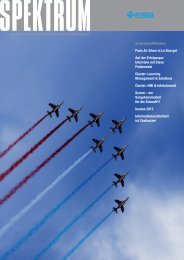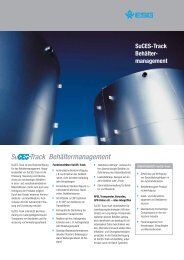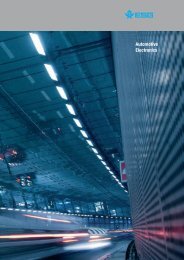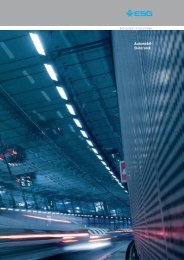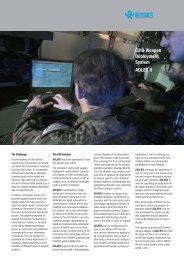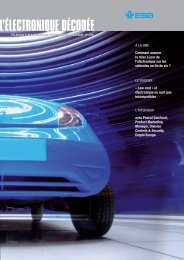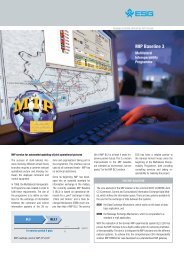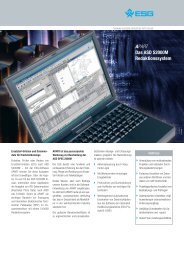ESG-Spektrum08-2.pdf, pages 1-16
ESG-Spektrum08-2.pdf, pages 1-16
ESG-Spektrum08-2.pdf, pages 1-16
Erfolgreiche ePaper selbst erstellen
Machen Sie aus Ihren PDF Publikationen ein blätterbares Flipbook mit unserer einzigartigen Google optimierten e-Paper Software.
ENGLISH SUMMARY<br />
Overcoming barriers for the “artificial<br />
passenger”<br />
Last fall, a major pile-up was caused<br />
by a bus slewed across the A9 freeway.<br />
It was blocking all three lanes,<br />
and only the hard shoulder was unobstructed.<br />
Three cars were approaching<br />
at the same time. The vehicle in the<br />
middle lane was “trapped” between<br />
the two vehicles in the right and left<br />
lanes. In this situation, the driver had<br />
no way of avoiding the accident unassisted.<br />
The car crashed into the bus at<br />
almost full speed, and numerous other<br />
vehicles drove into it immediately afterwards.<br />
For a long time, the major car manufacturers<br />
have been seeking solutions<br />
to avoid accidents in such situations.<br />
They are working on technology that<br />
will help the driver to avoid sudden<br />
obstacles – an “avoidance assistance<br />
function”. The idea behind it is that the<br />
vehicle autonomously coordinates the<br />
driving maneuvers performed in extreme<br />
situations. Such an assistance<br />
system is not feasible at present. Its<br />
complexity calls for new approaches<br />
to the structure of vehicle electronics<br />
networks.<br />
The architecture of today’s on-board<br />
networks is characterized by the unity<br />
of functions, control units and sensors.<br />
In other words, each assistance function<br />
is built with its own sensor and its<br />
own control unit. The architecture of tomorrow’s<br />
vehicle electronics networks<br />
will break up these units, significantly<br />
reducing the complexity of future vehicle<br />
network architectures by separating<br />
the functions from the hardware.<br />
Open system architectures of this kind<br />
are being developed in the AUTOSAR<br />
project; they represent the technical<br />
implementation of this requirement.<br />
One very important issue is the way in<br />
which the system passes its information<br />
to the driver. <strong>ESG</strong> has started to<br />
develop a corresponding communication<br />
management system for cars. The<br />
company’s wealth of know-how in the<br />
aviation sector facilitates the task.<br />
The primary goal of a communication<br />
management system is to avoid<br />
over-taxing the driver by coordinating<br />
the flow of information to the driver<br />
depending on the situation and the<br />
driver’s condition. Single items of information<br />
are linked to form more<br />
meaningful content and presented at<br />
the right moment.<br />
Training as a special event<br />
Last fall, the Oliver Wyman consulting<br />
company published its industry survey<br />
“Car Innovation 2015”. The survey revealed<br />
that many customers feel overwhelmed<br />
by the quantities of complex<br />
and unexplained innovations and the<br />
barrage of brand-specific names and<br />
abbreviations. A test carried out at 50<br />
car dealerships was even more alarming.<br />
The investigation of their ability to<br />
explain innovations revealed inadequate<br />
knowledge about the function and use<br />
of individual technologies, and thus a<br />
lack of interest in selling the innovative<br />
features. “On average today, only one<br />
in six available innovations is actually<br />
sold,” reported the Oliver Wyman consultants<br />
in their survey.<br />
One carmaker that has recognized the<br />
need to change this situation is Adam<br />
Opel GmbH. The Rüsselsheim-based<br />
vehicle manufacturer has set itself an<br />
ambitious goal: Each and every Opel<br />
salesperson should be fully convinced<br />
of the innovations created by the Opel<br />
group and be able to bring them over<br />
to the customer. The idea of the “Opel<br />
innovation tour” was born – a training<br />
tour for Opel sales staff at six different<br />
sites all over Germany. <strong>ESG</strong> was given<br />
the task of designing and implementing<br />
this novel series of events.<br />
A total of twelve all-day events were<br />
held in six different cities. At each of<br />
these training sessions, Opel grouped<br />
its innovations into four thematic packages,<br />
and workshops were held on<br />
each one of them.<br />
The event was a great success with the<br />
1400 or so salespeople who attended,<br />
says Michael Hatz, head of sales and<br />
service training at Adam Opel GmbH.<br />
In his opinion, the competent training<br />
team from <strong>ESG</strong> was a great asset. The<br />
team’s “Opel innovation tour” was a<br />
creative and intuitive training concept,<br />
he said, and the car manufacturer was<br />
eminently satisfied with it.<br />
Worldwide access to vehicle data<br />
The Volkswagen group is currently redeveloping<br />
its entire diagnosis software.<br />
ODIS (Off-board Diagnosis Information<br />
System) is the name given to a new<br />
generation of system solutions that will<br />
be utilized in the Volkswagen group’s<br />
service sector around the world. <strong>ESG</strong><br />
has developed the diagnosis editing<br />
system – one of the two central pillars<br />
of the new software solution. According<br />
to Volkswagen, ODIS will allow service<br />
technicians to access all systems and<br />
information that are relevant to vehicle<br />
diagnosis. “Repair reliability and customer<br />
satisfaction increase, while garage<br />
and warranty costs decrease.”<br />
In future, the <strong>ESG</strong> solution will enable<br />
the Volkswagen group to register all<br />
data required by the service points at<br />
source. The system thus represents the<br />
basis for a uniform diagnosis process<br />
throughout the Volkswagen group. The<br />
system provides all the functions that<br />
are needed to create diagnosis information,<br />
and embeds them in the appropriate<br />
working environment.<br />
RFID in the German armed forces<br />
It’s a day like any other in a German<br />
army parachute unit: A paratrooper<br />
is being issued with the equipment to<br />
perform a jump exercise. As he receives<br />
his parachute and the auxiliary equipment,<br />
an alarm message suddenly<br />
appears on the computer: “CAUTION –<br />
parachute system unfit for service”.<br />
What sounded futuristic in the military<br />
environment only a few years ago, is<br />
meanwhile everyday reality: A computer-based<br />
logistics system monitors the<br />
condition of all components in real time<br />
and interactively supports the ground<br />
personnel in all aspects of the service<br />
availability processes.<br />
The novel logistics solution is part of<br />
the gliding parachute system for the<br />
German army special forces. This<br />
system involves a vast number of activities<br />
to ensure operational readiness<br />
at all times. The maintenance, repair,<br />
verification and packing, the storage<br />
of the oxygen, parachute and auxiliary<br />
equipment must be perfectly attuned<br />
to one another. All associated records<br />
of checks carried out, clearance for<br />
use, and issue to paratroopers were<br />
initially to be documented exclusively<br />
on paper. <strong>ESG</strong> thereupon proposed an<br />
RFID-based logistics solution that not<br />
only fulfills all of the requirements met<br />
by the existing paper documentation,<br />
but moreover takes care of all issues<br />
involved in ensuring long-term smooth<br />
operation. The novel solution was given<br />
the name “Daidalos”. All workstations<br />
involved in the processes at the respective<br />
site are equipped with a computer<br />
on which the Daidalos software is installed.<br />
In this way, changes to the condition<br />
of the parachute system can be<br />
registered and entered into the system<br />
at any location. All data are collected in<br />
a central database at the site and additionally<br />
processed for an electronic<br />
life-cycle file. This makes it possible<br />
to generate a complete history of each<br />
monitored subassembly whenever required.<br />
The condition of the parachute<br />
system is checked on issue to the action<br />
forces – and if a faulty subsystem<br />
is identified, the entire system is automatically<br />
barred from use.<br />
A blueprint for logistics?<br />
MDN pro is the key: This “material planning<br />
network”, a complex IT solution by<br />
<strong>ESG</strong>, is at the core of the company’s<br />
outsourcing service in the areas of<br />
materials management, warehousing<br />
administration, and the control of shipments<br />
and equipment rotation. The system<br />
has placed <strong>ESG</strong> firmly on the map<br />
as a lead logistics provider.<br />
MDN pro is currently being used by<br />
<strong>ESG</strong> in the centralized management<br />
of over 50 decentralized federal warehouses<br />
(BEL) and corresponding MRO<br />
facilities of the Luftwaffe. The company<br />
is also applying its know-how in<br />
the operation of a central warehouse<br />
(ZEBEL), which supplies around 150<br />
civilian companies and military maintenance<br />
facilities involved in the repair<br />
of defense systems and vehicles for<br />
the Joint Support Service of the armed<br />
forces. <strong>ESG</strong> works in partnership with<br />
the transport and logistics company DB<br />
Schenker. Another prominent project is<br />
the “HIL-Baugruppen-Drehkreuz” (assembly<br />
hub).<br />
Meanwhile, the cooperation between<br />
the Bundeswehr, <strong>ESG</strong> and DB Schenker<br />
has become synonymous with successful<br />
outsourcing, as well as for a productive<br />
partnership between the public and<br />
private sector – a genuine ‘lighthouse<br />
project’. At the close of the first ZEBEL<br />
project year, the German Federal Audit<br />
Office even noted savings of over onethird<br />
in direct costs compared with<br />
previous operations. Further optimization<br />
has been implemented in ongoing<br />
operations on a continuous basis.<br />
Thus, the two projects “ZEBEL” and<br />
“BEL Lw” could act as a blueprint for the<br />
sub-project “warehousing and distribution”<br />
for the “Logistics Project Outline”<br />
and serve as an important role model.<br />
Abandonment of the contract-specific<br />
consignment of stock, a task unique to<br />
ZEBEL, would mean a considerable setback<br />
in the maintenance process.



